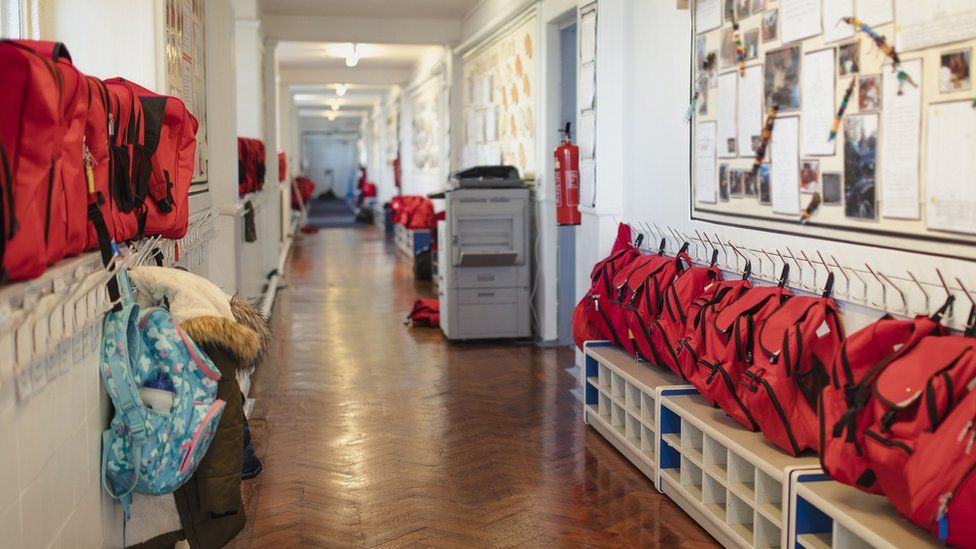 Image source, Getty Images
Image source, Getty Images
By Nathan Standley
BBC News
The number of schools in England affected by crumbling concrete has increased to 174, new figures published by the government show.
The number stood at 147 as of 30 August, but has increased by 27 as of 14 September.
Officials said surveyors had been checking hundreds of schools every week for reinforced autoclaved aerated concrete, known as Raac.
The government said it would be updating its list every two weeks.
Despite the increase in cases of confirmed Raac, more pupils in affected schools have been able to return to full-time face-to-face education since the first list was released.
A number of schools had to delay their September term restart as the Department for Education (DfE) told them to close areas where Raac was present.
Only one setting still has pupils in full remote learning, down from four two weeks ago. Twenty-three settings are providing a mix of face-to-face and remote arrangements, up from 20 on 30 August.
There are no schools which remain closed following the summer holidays. In the first set of figures, there were 19 either closed or delaying the start of term due to Raac.
Three post-16 education settings have also been added to the list of sites affected by crumbling concrete.
Education Secretary Gillian Keegan said the government was taking a "cautious approach".
"School and local leaders deserve huge credit for making sure the vast majority of settings with confirmed Raac are continuing to offer pupils face-to-face learning - including all of the 147 schools initially identified two weeks ago," she said.
Raac is a lightweight material that was used mostly in flat roofing, but also in floors and walls, between the 1950s and 1990s. It is a cheaper alternative to standard concrete and has a lifespan of about 30 years.
Officials have been aware of issues with Raac for decades. But in June this year, a report by the National Audit Office said years of insufficient funding had increased the risk of a building collapse.
Over the summer, a Raac panel that would have been classed as "non-critical" collapsed at a school in England - leading to the final decision to take action. You can find a full timeline of how the concrete crisis developed here.
Education minister Baroness Barran and the DfE's permanent secretary Susan Acland-Hood answered questions from the education select committee about the crisis on Tuesday morning.
On temporary classrooms, MPs were told:
Paul Whiteman, general secretary of the National Association of Head Teachers (NAHT) union, said the new list of affected schools was an "important update", but called for a "clear plan" to repair and replace damaged buildings over a longer period.
Education Baroness Barran was also questioned on Tuesday about the short notice schools received that they would have to close affected areas.
Schools with Raac were told on 31 August that they would have to close affected areas that did not have safety mitigations in place, just days before the start of term.
She told MPs the department "couldn't have acted quicker" and said ministers recommended the most cautious approach to the Secretary of State.
In Scotland, schools in 16 local authorities have been found to contain Raac and surveys will be carried out at 120 schools across Northern Ireland to check for the concrete, the Education Authority has said.
Elliot, a year eight pupil at Myton School in Warwick, logs on for a day of remote learning on Tuesday morning
Fay Arrundale's son Elliot attends Myton School in Warwick, but the secondary school has had to close part of its site because of Raac, and is now having different year groups attend in alternate weeks.
Year eight pupil Elliot logged on for his remote school day on Tuesday morning from his home, which is a short distance away from the school.
"It's quite annoying because it's only just there, so it is frustrating," he said.
"It's very different to being in school because it's a very different environment. [I miss] my friends, and I worry that if this goes on for too long I will be behind on my education.
"We won't learn much if we're just sat behind a screen."
How are you being impacted by the ongoing problems with Raac? Tell us your story by emailing us at: [email protected].
Please include a contact number if you are willing to speak to a BBC journalist. You can also get in touch in the following ways:
If you are reading this page and can't see the form you will need to visit the mobile version of the BBC website to submit your question or comment or you can email us at [email protected]. Please include your name, age and location with any submission.

 7 months ago
7 months ago
.png)









